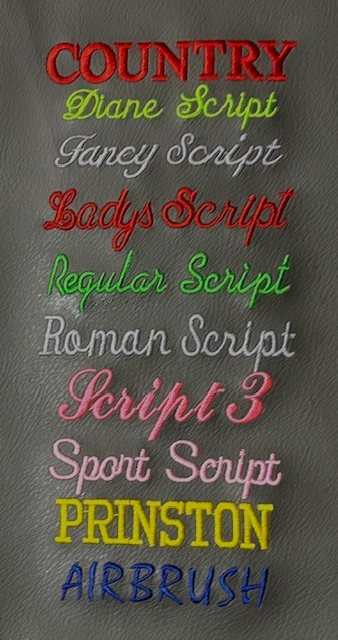Heat Transfer on T-Shirts and Aprons - Personalized Designs and Logos
Heat Transfer on T-Shirts and Aprons - Personalized Designs and Logos
Blog Article
The Art of Custom-made Needlework: Unlocking the Keys to Creating Distinct and Remarkable Designs
Needlework, a craft soaked in custom and artistry, holds within its detailed stitches the power to change textile right into a canvas of one-of-a-kind expression. The keys to producing personalized needlework layouts that astound the eye and leave a long-term perception depend on a fragile balance of technique, creativity, and interest to information. As we dive into the world of personalized needlework, we uncover the nuanced interplay between string choice, stitch complexity, and style personalization that raises a mere garment to a job of art. Join us on a journey with the art of personalized needlework as we decipher the secrets behind crafting truly memorable and unique creations.
Choosing the Right Needlework Threads
When selecting embroidery strings, what vital factors should you consider to ensure the most effective results for your custom designs? The choice of embroidery string is vital in determining the final outcome of your stitched layout. Among the main factors to consider is the material of the string. Different materials such as cotton, polyester, rayon, and silk offer differing degrees of shine, resilience, and structure. It is necessary to choose a thread product that matches the fabric you are embroidering on and aligns with the wanted look of the style.
Thicker strings can add measurement and appearance to your design, while finer threads are suitable for elaborate details and tiny message. Furthermore, taking into consideration the color fastness and washability of the thread is important to guarantee that your custom-made layouts keep their top quality and vibrancy over time.
Discovering Various Stitch Methods
To explore the world of 'Discovering Different Stitch Strategies', one need to understand the ins and outs and subtleties that each stitching technique offers the art of needlework. Various stitch techniques not only include visual interest but additionally contribute to the overall appearance and measurement of the design. One prominent stitch technique is the satin stitch, which involves carefully packed parallel stitches to create a smooth and shiny surface, ideal for filling out forms and developing strong details.
On the various other hand, the backstitch is a versatile technique usually used for outlining and adding great details. It includes stitching backwards to create a solid line of needlework. Furthermore, the French knot stitch adds a tactile element to styles, ideal for developing distinctive accents like blossom centers or decorative touches.
Checking out various stitch methods allows embroiderers to have fun with light, darkness, and deepness within their designs, elevating the visual charm and imaginative high quality of their needlework jobs. By understanding different stitching methods, one can open limitless opportunities for creating special and memorable customized embroidery items.
Incorporating Personalized Style Elements
Having discovered the ins and outs of various stitch methods such as the satin stitch, backstitch, and French knot, the focus now shifts in the direction of integrating personalized layout components in custom embroidery tasks. Personalized layout aspects play an important function in making page needlework tasks genuinely unique and unforgettable. One method to include personalization is by adding initials, names, or considerable dates to the design. This not only includes a personalized touch but additionally boosts the sentimental value of the embroidery piece.
One more way to incorporate individualized design aspects is by consisting of signs or themes that hold special definition to the recipient or reflect their rate of interests and individuality. Incorporating a favored blossom, animal, or hobby-related sign can make the embroidery design extra meaningful and individualized. Furthermore, selecting shades that resonate with the recipient or align with the intended style can further enhance the customization of the embroidery project.
Understanding the Art of Shade Sychronisation
One key facet of color sychronisation is understanding shade theory. This consists of knowing how different shades connect with each other, the feelings they convey, and exactly how they can be combined to develop visually enticing styles. By using color concept principles, embroiderers can create unified shade palettes that improve the overall look of the design.
Additionally, paying focus to comparison is critical in color coordination. Making use of contrasting shades can aid particular aspects of the design pop, boost clarity, and create a visually vibrant embroidery piece. By grasping the art of color coordination, embroiderers can elevate their styles and produce remarkable items that resonate with clients and audiences alike.
Enhancing Appearance With Advanced Embroidery Stitches

French knots, as an example, are excellent for including little, elevated dots to your design, imitating the look of grains or developing a textured surface. Bullion knots, on the other hand, can be used to develop twisted, ropelike elements that include an elegant feeling to the embroidery. Seed sewing entails tiny, scattered stitches that can fill up in locations with a polychromatic structure, while turkey job creates cosy, dimensional accents reminiscent of animal hair or foliage. Try out these sophisticated needlework stitches allows you to press the boundaries of typical needlework and produce really unique and aesthetically attractive textures in your designs.
Final Thought
In conclusion, the art of customized needlework entails a combination of selecting the best threads, exploring numerous stitch techniques, incorporating individualized layout aspects, mastering color control, and improving texture with innovative stitches. By comprehending and applying these crucial elements, embroiderers can develop special and unforgettable designs that display their imagination and skill. Embroidery lovers can navigate to these guys open the tricks to producing gorgeous and custom pieces that stand out and leave a long lasting impact.
Report this page